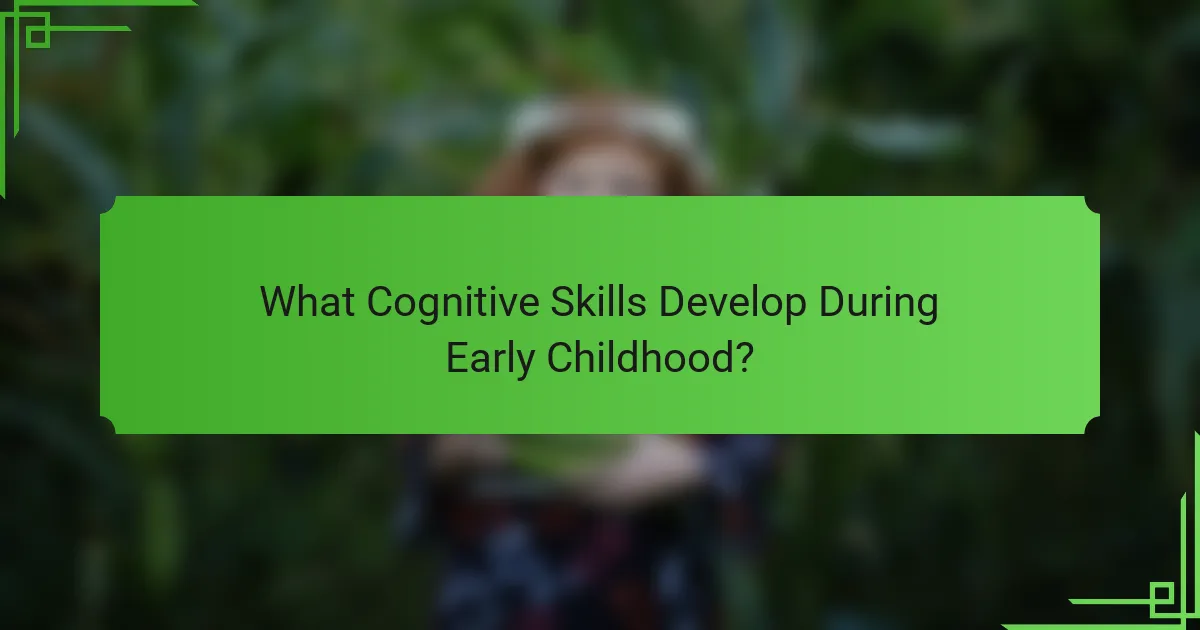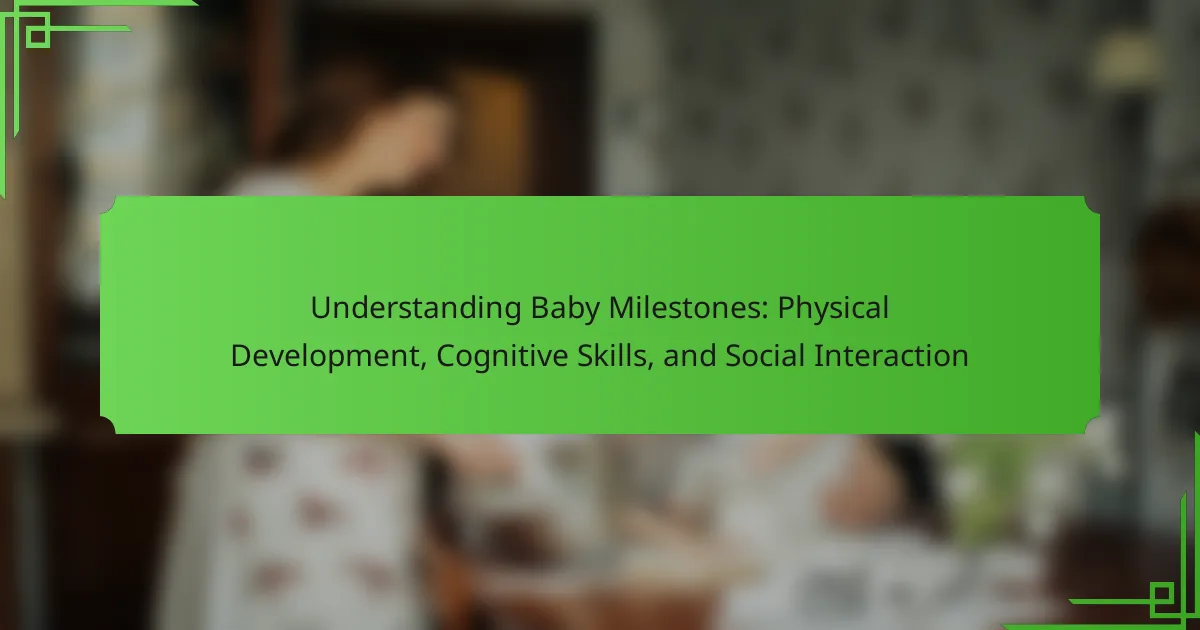Baby milestones in development are crucial indicators of an infant’s growth and include physical, cognitive, and social skills achieved at specific ages. Physical milestones encompass actions such as rolling over, sitting up, crawling, and walking, typically observed within defined age ranges. Cognitive milestones involve memory, attention, problem-solving, and language skills, forming the basis for future learning and social interactions. Social milestones include behaviors like smiling, making eye contact, and forming attachments to caregivers. The Centers for Disease Control and Prevention (CDC) provides guidelines on these milestones, aiding in the monitoring of healthy development and the identification of potential delays.

What are Baby Milestones in Development?
Baby milestones in development are significant skills or behaviors that infants typically achieve at certain ages. These milestones include physical, cognitive, and social skills. Physical milestones involve actions like rolling over, sitting up, and walking. Cognitive milestones encompass skills such as recognizing faces and responding to their name. Social milestones include smiling, making eye contact, and showing attachment to caregivers. The Centers for Disease Control and Prevention (CDC) outlines these milestones, indicating that most babies reach them within a specific age range, which helps monitor healthy development. Tracking these milestones can aid in identifying potential developmental delays.
Why are Baby Milestones Important for Growth?
Baby milestones are crucial for growth because they indicate a child’s developmental progress. Tracking these milestones helps parents and caregivers assess physical, cognitive, and social skills. For instance, a baby typically starts to crawl around 6 to 10 months. This crawling stage enhances muscle strength and coordination. Similarly, reaching for objects at around 4 to 6 months supports fine motor skills. Research shows that meeting these milestones correlates with later success in learning and social interactions. Delays in milestones may signal the need for early intervention. The Centers for Disease Control and Prevention (CDC) emphasizes monitoring milestones to ensure healthy development.
How do Baby Milestones Reflect a Child’s Development?
Baby milestones reflect a child’s development by indicating progress in physical, cognitive, and social skills. These milestones serve as benchmarks for assessing growth. For example, rolling over typically occurs around four to six months, showing physical strength and coordination. Crawling, which usually happens between six to ten months, indicates increasing mobility and exploration. By the age of one, many babies can stand and take their first steps, demonstrating significant physical development.
Cognitive milestones include recognizing familiar faces and responding to their names by six months. This indicates growing awareness and understanding of their environment. By twelve months, many babies can follow simple instructions, showcasing cognitive growth.
Social milestones, such as smiling and engaging in reciprocal play, appear as early as two months. By the age of one, babies often show attachment to caregivers, reflecting emotional and social development. Tracking these milestones helps caregivers identify any potential developmental delays. Regular assessments can ensure timely interventions if needed.
What are the Key Areas of Development Covered by Milestones?
The key areas of development covered by milestones are physical development, cognitive skills, and social interaction. Physical development includes gross and fine motor skills, such as crawling and grasping. Cognitive skills involve problem-solving, memory, and language acquisition. Social interaction encompasses emotional development, attachment, and communication with others. These areas are critical for assessing a child’s growth and readiness for future challenges. Milestones provide benchmarks for parents and caregivers to monitor progress in these domains effectively.
What are the Different Types of Baby Milestones?
The different types of baby milestones include physical milestones, cognitive milestones, and social-emotional milestones. Physical milestones involve gross and fine motor skills, such as rolling over, sitting up, and grasping objects. Cognitive milestones relate to a baby’s ability to think and learn. These include recognizing faces, responding to their name, and problem-solving. Social-emotional milestones encompass a child’s interactions with others. This includes smiling, showing attachment, and expressing emotions. Each type of milestone signifies critical areas of development that occur during infancy and early childhood. Tracking these milestones helps caregivers understand a child’s growth and development.
How do Physical Milestones Manifest in Infants?
Physical milestones in infants manifest as observable developmental achievements. These milestones include rolling over, sitting up, crawling, and walking. Infants typically roll over by 4 to 6 months. They often sit up without support around 6 to 8 months. Crawling usually begins between 7 to 10 months. Most infants take their first steps between 9 to 15 months. Each milestone indicates the growth of motor skills and coordination. These developments follow a predictable timeline, allowing caregivers to monitor progress. Pediatricians use these milestones to assess healthy development in infants.
What Cognitive Skills are Developed During Early Childhood?
Cognitive skills developed during early childhood include problem-solving, memory, language, and reasoning. During this stage, children learn to think critically and understand their environment. They begin to recognize patterns and make connections between concepts. Memory skills improve as they recall information and experiences. Language development allows them to communicate thoughts and feelings effectively. Additionally, reasoning skills emerge as children start to understand cause and effect relationships. Research shows that these skills are foundational for later academic success and social interactions.
How do Social Interaction Milestones Evolve in Babies?
Social interaction milestones in babies evolve through distinct stages as they grow. In the first few months, babies primarily engage in non-verbal communication. They use crying and cooing to express needs. By around 3 to 6 months, they start to smile socially and respond to caregivers’ expressions. This indicates the beginning of emotional connection.
At 6 to 12 months, babies begin to engage in turn-taking during interactions. They may babble in response to others and show preference for familiar people. By 12 months, they typically start to use gestures like waving and pointing. This marks a significant step in their ability to communicate intentions.
Between 12 to 18 months, babies often begin to imitate actions and sounds. They may show interest in playing alongside other children, known as parallel play. By 18 to 24 months, they typically engage in more interactive play, sharing toys and taking turns. These behaviors reflect their growing understanding of social dynamics.
Research shows that these milestones are crucial for developing social skills. The American Academy of Pediatrics emphasizes the importance of these interactions for emotional and cognitive development.

How Do Physical Development Milestones Progress?
Physical development milestones progress in a predictable sequence during infancy and early childhood. These milestones include skills such as rolling over, sitting up, crawling, and walking. Typically, infants begin to roll over by 4 to 6 months. By 6 to 8 months, most can sit without support. Crawling usually occurs between 7 to 10 months. Walking often begins around 12 months, with many children taking their first steps. Each milestone builds upon the previous one, showcasing a child’s growing strength and coordination. Research indicates that these milestones are influenced by both genetic and environmental factors. The Centers for Disease Control and Prevention (CDC) provides guidelines on expected developmental timelines, reinforcing the standard progression of these physical skills.
What are the Typical Physical Milestones for Infants?
Typical physical milestones for infants include rolling over, sitting up, crawling, and walking. Infants usually roll over by 4 to 6 months. They typically sit up without support by 6 to 8 months. Crawling usually occurs between 7 to 10 months. Most infants take their first steps around 9 to 12 months. These milestones reflect the physical development stages that infants go through. Each milestone aligns with developmental guidelines set by pediatric professionals. For instance, the Centers for Disease Control and Prevention (CDC) provides age-specific milestones for tracking infant growth and development.
When Should Babies Start Rolling Over and Sitting Up?
Babies typically start rolling over between 4 to 6 months of age. This milestone indicates developing muscle strength and coordination. Most infants begin to sit up independently around 6 to 8 months. Sitting requires core stability and balance, which develop over time. Research indicates that these milestones can vary slightly among individual babies. According to the American Academy of Pediatrics, each child develops at their own pace. Regular pediatric check-ups can help monitor these milestones.
What Physical Skills Develop Between 6 to 12 Months?
Between 6 to 12 months, babies develop several key physical skills. These skills include sitting up without support, crawling, and pulling themselves up to stand. By around 6 months, most infants can sit independently for short periods. Crawling typically begins around 7 to 10 months, allowing babies to explore their environment. By 9 to 12 months, many infants can pull themselves up to a standing position, often using furniture for support. Some may even begin to take their first steps during this period. These milestones reflect significant growth in muscle strength and coordination. The progression of these skills is closely monitored by pediatricians as indicators of healthy physical development.
How Can Parents Support Physical Development?
Parents can support physical development by providing opportunities for active play. Engaging in activities like crawling, walking, and climbing enhances motor skills. Parents should encourage outdoor play to promote physical fitness. Structured activities, such as swimming or dance, can also aid development. Regularly interacting with their child during play fosters coordination and balance. Providing safe environments allows children to explore movement freely. Offering age-appropriate toys can stimulate physical engagement and coordination. Research shows that active play contributes to overall health and developmental milestones.
What Activities Promote Physical Milestones in Babies?
Activities that promote physical milestones in babies include tummy time, crawling, and reaching for toys. Tummy time encourages neck and upper body strength. This activity helps babies develop the muscles needed for rolling over and sitting up. Crawling enhances coordination and balance. Reaching for toys improves hand-eye coordination and fine motor skills. Other activities like dancing and gentle stretching also support physical development. Engaging in these activities consistently fosters growth and achievement of key milestones. Studies show that active play is crucial for developing motor skills in infants.
How Can Parents Identify Delays in Physical Development?
Parents can identify delays in physical development by observing their child’s ability to meet developmental milestones. Milestones include skills such as rolling over, sitting up, crawling, and walking. If a child does not achieve these skills within the expected age range, it may indicate a delay. For example, most infants roll over by six months and walk by 12 to 15 months.
Parents should also monitor coordination and balance. A lack of these skills may suggest developmental issues. Regular pediatric check-ups can provide professional assessments of physical development. Pediatricians use standardized growth charts to track physical milestones. If concerns arise, parents can seek early intervention services. Early detection is crucial for effective support and development.

What Cognitive Skills Develop During Early Childhood?
Cognitive skills that develop during early childhood include memory, attention, problem-solving, and language skills. Memory allows children to retain information and recall it later. Attention helps them focus on tasks and filter out distractions. Problem-solving skills enable children to find solutions to challenges they encounter. Language skills facilitate communication and expression of thoughts and feelings. These cognitive skills form the foundation for later learning and development. Research indicates that these skills are crucial for academic success and social interactions in later years.
How Do Cognitive Milestones Manifest in Infants?
Cognitive milestones in infants manifest through observable behaviors and skills. These milestones include recognizing familiar faces and responding to their names by around six months. By eight to twelve months, infants begin to understand object permanence, showing they know objects still exist even when out of sight. At twelve months, many infants can follow simple directions and engage in basic problem-solving, like pulling a blanket to retrieve a toy. Between twelve and eighteen months, vocabulary expands, and infants start to use simple words. By two years, they can form two-word phrases and demonstrate a growing understanding of cause and effect. Each of these milestones reflects cognitive development stages supported by research in developmental psychology.
What are the Key Cognitive Skills to Look for in Babies?
Key cognitive skills to look for in babies include attention, memory, problem-solving, and language development. Attention is the ability to focus on objects or sounds. Babies show this by tracking moving objects with their eyes. Memory involves recalling past experiences or recognizing familiar faces. Babies demonstrate memory by reacting differently to known versus unknown people. Problem-solving skills emerge as babies explore their environment and figure out how to reach toys. Language development begins with cooing and babbling, transitioning to word recognition. These skills typically develop in stages, with attention and memory becoming noticeable in the first few months. By six months, babies often show improved problem-solving abilities. By the end of the first year, many can understand simple words and phrases, indicating language growth.
How Do Problem-Solving Skills Evolve in Infants?
Problem-solving skills in infants evolve through stages of cognitive development. Initially, infants engage in trial-and-error methods. They explore their environment by manipulating objects. As they grow, they begin to understand cause-and-effect relationships. This understanding enhances their ability to solve simple problems. Research indicates that by around 8 to 12 months, infants can anticipate outcomes. They demonstrate problem-solving by using tools or reaching for distant objects. By 18 months, their skills further develop, allowing for more complex problem-solving. This progression is supported by studies showing cognitive growth correlates with increased problem-solving abilities.
What Role Does Play Have in Cognitive Development?
Play is essential for cognitive development in children. It enhances problem-solving skills and promotes creativity. Through play, children engage in exploration and experimentation. This interaction with their environment fosters critical thinking. Research shows that play supports language development and social skills. A study by Ginsburg (2007) emphasizes that play is a vital component of learning. It provides opportunities for children to practice decision-making. Play also encourages emotional regulation and resilience. Overall, active engagement in play significantly contributes to cognitive growth.
How Can Parents Encourage Cognitive Skills Through Play?
Parents can encourage cognitive skills through play by providing stimulating activities. Engaging in puzzles enhances problem-solving abilities. Role-playing games foster imagination and social skills. Building blocks improve spatial awareness and hand-eye coordination. Reading together develops language skills and comprehension. Interactive games promote critical thinking and decision-making. According to research, play-based learning significantly boosts cognitive development in early childhood. The American Academy of Pediatrics emphasizes the importance of play in enhancing cognitive growth.
What Are the Signs of Cognitive Delays in Development?
Signs of cognitive delays in development include difficulty in problem-solving and limited understanding of concepts. Children may struggle to follow directions or have trouble with memory tasks. Delays in language development are also common, such as limited vocabulary or difficulty forming sentences. Additionally, challenges in social interactions may arise, including difficulty in understanding social cues or engaging with peers. Research indicates that early intervention can significantly improve outcomes for children showing these signs. According to the CDC, developmental monitoring is essential for identifying potential delays early on.
